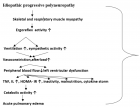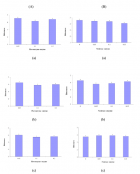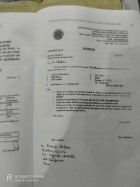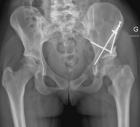Abstract
Case Report
Idiopathic progressive polyneuropathy presented with frequently acute pulmonary oedema: a case report
Nazmi Gultekin*
Published: 29 September, 2022 | Volume 6 - Issue 2 | Pages: 045-048
Neuropathy is when nerve damage interferes with the functioning of the peripheral nervous system (PNS). When the cause can’t be determined, it’s called idiopathic neuropathy(Idiopathic neuropathy, now designated as chronic idiopathic axonal polyneuropathy (CIAP).
There are three kinds of nerves within the PNS. Sensory nerves relay messages from the sense organs to the brain. This allows sensations of temperature and touch. Motor nerves transmit signals from the brain to the muscles. This helps the brain control the muscles. Autonomic nerves control body functions like heart rate, breathing, and digestion.
Damage to nerve cells can affect how the PNS communicates with the rest of the body. Symptoms can include numbness, pain, and balance issues.
It’s called acute neuropathy when symptoms develop suddenly. Alternately, it’s called chronic neuropathy when symptoms start slowly and increase over time. Diagnosis involves physical examination and review of medical history. Diagnostic testing may include blood tests, nerve testing, and imaging tests.
There is no cure for idiopathic neuropathy. Treatments including medication, physical therapy, and lifestyle modifications can help you function and feel better.
We report a case of idiopathic polyneuropathy presented with frequent acute pulmonary edema for a year.
Read Full Article HTML DOI: 10.29328/journal.jnnd.1001068 Cite this Article Read Full Article PDF
Keywords:
Polyneuropathy; Acute pulmonary edema; Prednisolone; ACTH
References
- Ware LB, Matthay MA. Clinical practice. Acute pulmonary edema. N Engl J Med. 2005 Dec 29;353(26):2788-96. doi: 10.1056/NEJMcp052699. PMID: 16382065.
- O'Leary, R.; McKinlay, J. (2011). "Neurogenic pulmonary oedema". Continuing Education in Anaesthesia, Critical Care & Pain. 11(3): 87–92. doi:1093/bjaceaccp/mkr006.
- Givertz MM, Gottlieb SS, Finlay G. Noncardiogenic pulmonary edema. https://www.uptodate.com/contents/noncardiogenic-pulmonary-edema.Feb 6, 2018.
- What is peripheral neuropathy. The Foundation for Peripheral Neuropathy. https://www.foundationforpn.org/what-is-peripheral-neuropathy/. Accessed April 2, 2016.
- Rutkove SB. Overview of polyneuropathy. http://www.uptodate.com/home. Accessed April 2, 2016.
- Vrancken AF, Franssen H, Wokke JH, Teunissen LL, Notermans NC. Chronic idiopathic axonal polyneuropathy and successful aging of the peripheral nervous system in elderly people. Arch Neurol. 2002 Apr;59(4):533-40. doi: 10.1001/archneur.59.4.533. PMID: 11939887.
- Visser NA, Vrancken AF, van der Schouw YT, van den Berg LH, Notermans NC. Chronic idiopathic axonal polyneuropathy is associated with the metabolic syndrome. Diabetes Care. 2013 Apr;36(4):817-22. doi: 10.2337/dc12-0469. Epub 2012 Nov 30. PMID: 23204246; PMCID: PMC3609524.
- Demirhan A, Yasar Tekelioglu U, Akkaya A, Dagistan E, Suzi Ayhan S, Ozturk S, Yildiz I, Kocoglu H. Magnetic resonance imaging contrast agent related pulmonary edema: a case report. Eur Rev Med Pharmacol Sci. 2012 Oct;16 Suppl 4:110-2. PMID: 23090824.
- Sprooten RTM, Otte AAB, Cobben NAM, Steijns SCM, Rohde GGU, Wouters EFM. Orthopnea due to phrenic nerve involvement in neuralgic amyothrophy. European Respiratory Journal.2014 44: P452.
- Burton C, Chesterton LS, Davenport G. Diagnosing and managing carpal tunnel syndrome in primary care. Br J Gen Pract. 2014 May;64(622):262-3. doi: 10.3399/bjgp14X679903. PMID: 24771836; PMCID: PMC4001168.
- Cahalin LP, Arena R, Guazzi M, Myers J, Cipriano G, Chiappa G, Lavie CJ, Forman DE. Inspiratory muscle training in heart disease and heart failure: a review of the literature with a focus on method of training and outcomes. Expert Rev Cardiovasc Ther. 2013 Feb;11(2):161-77. doi: 10.1586/erc.12.191. Erratum in: Expert Rev Cardiovasc Ther. 2013 Apr;11(4):520. PMID: 23405838; PMCID: PMC7304053.
- Berbenetz N, Wang Y, Brown J, Godfrey C, Ahmad M, Vital FM, Lambiase P, Banerjee A, Bakhai A, Chong M. Non-invasive positive pressure ventilation (CPAP or bilevel NPPV) for cardiogenic pulmonary oedema. Cochrane Database Syst Rev. 2019 Apr 5;4(4):CD005351. doi: 10.1002/14651858.CD005351.pub4. PMID: 30950507; PMCID: PMC6449889.
Figures:

Figure 1
Similar Articles
-
Idiopathic progressive polyneuropathy presented with frequently acute pulmonary oedema: a case reportNazmi Gultekin*. Idiopathic progressive polyneuropathy presented with frequently acute pulmonary oedema: a case report. . 2022 doi: 10.29328/journal.jnnd.1001068; 6: 045-048
Recently Viewed
-
The Inverse Relationship between Acute Myocardial Infarction and Dissolved Oxygen Levels in WaterArturo Solís Herrera*,María del Carmen Arias Esparza,Ruth Isabel Solís Arias. The Inverse Relationship between Acute Myocardial Infarction and Dissolved Oxygen Levels in Water. J Nov Physiother Rehabil. 2025: doi: 10.29328/journal.jnpr.1001066; 9: 013-023
-
The evolving landscape of ENT disorder treatments: Recent advances and innovations (2019-2021) – A CommentaryYRKM Sai*. The evolving landscape of ENT disorder treatments: Recent advances and innovations (2019-2021) – A Commentary. Adv Treat ENT Disord. 2021: doi: 10.29328/journal.ated.1001012; 5: 001-004
-
The role of islamic lifestyle and healthy nutrition in accordance with the recommendations of islam and the holly quran by focusing on the risk of cancer incidentRoya Dolatkhah*,Pooneh Jabbaripour,Mohammad Hossein Somi,Ali Roshani. The role of islamic lifestyle and healthy nutrition in accordance with the recommendations of islam and the holly quran by focusing on the risk of cancer incident. J Community Med Health Solut. 2020: doi: 10.29328/journal.jcmhs.1001002; 1: 018-022
-
Myeloid Neoplasms: Better Understanding of their Molecular Pathogenesis with Improvised Genomic Testing: A Ray of Hope for Better Clinical OutcomesBhardwaj Tina Neelesh*, Phani MN. Myeloid Neoplasms: Better Understanding of their Molecular Pathogenesis with Improvised Genomic Testing: A Ray of Hope for Better Clinical Outcomes. J Hematol Clin Res. 2024: doi: 10.29328/journal.jhcr.1001027; 8: 001-007
-
Prevalence and Risk Factors to Preterm Labor through a Study in Jiblah University Hospital, Ibb, Governorate, YemenAfaf Alsharif*,Zainab Said,Fatima Mokabes,Leena Ameen,Alya Alqadri,Thekra Musaed,Bushra Musaed,Ala’a Ahmed,Halaa Rigih. Prevalence and Risk Factors to Preterm Labor through a Study in Jiblah University Hospital, Ibb, Governorate, Yemen. J Community Med Health Solut. 2025: doi: 10.29328/journal.jcmhs.1001053; 6: 020-026
Most Viewed
-
Evaluation of Biostimulants Based on Recovered Protein Hydrolysates from Animal By-products as Plant Growth EnhancersH Pérez-Aguilar*, M Lacruz-Asaro, F Arán-Ais. Evaluation of Biostimulants Based on Recovered Protein Hydrolysates from Animal By-products as Plant Growth Enhancers. J Plant Sci Phytopathol. 2023 doi: 10.29328/journal.jpsp.1001104; 7: 042-047
-
Sinonasal Myxoma Extending into the Orbit in a 4-Year Old: A Case PresentationJulian A Purrinos*, Ramzi Younis. Sinonasal Myxoma Extending into the Orbit in a 4-Year Old: A Case Presentation. Arch Case Rep. 2024 doi: 10.29328/journal.acr.1001099; 8: 075-077
-
Feasibility study of magnetic sensing for detecting single-neuron action potentialsDenis Tonini,Kai Wu,Renata Saha,Jian-Ping Wang*. Feasibility study of magnetic sensing for detecting single-neuron action potentials. Ann Biomed Sci Eng. 2022 doi: 10.29328/journal.abse.1001018; 6: 019-029
-
Pediatric Dysgerminoma: Unveiling a Rare Ovarian TumorFaten Limaiem*, Khalil Saffar, Ahmed Halouani. Pediatric Dysgerminoma: Unveiling a Rare Ovarian Tumor. Arch Case Rep. 2024 doi: 10.29328/journal.acr.1001087; 8: 010-013
-
Physical activity can change the physiological and psychological circumstances during COVID-19 pandemic: A narrative reviewKhashayar Maroufi*. Physical activity can change the physiological and psychological circumstances during COVID-19 pandemic: A narrative review. J Sports Med Ther. 2021 doi: 10.29328/journal.jsmt.1001051; 6: 001-007

HSPI: We're glad you're here. Please click "create a new Query" if you are a new visitor to our website and need further information from us.
If you are already a member of our network and need to keep track of any developments regarding a question you have already submitted, click "take me to my Query."
















































































































































